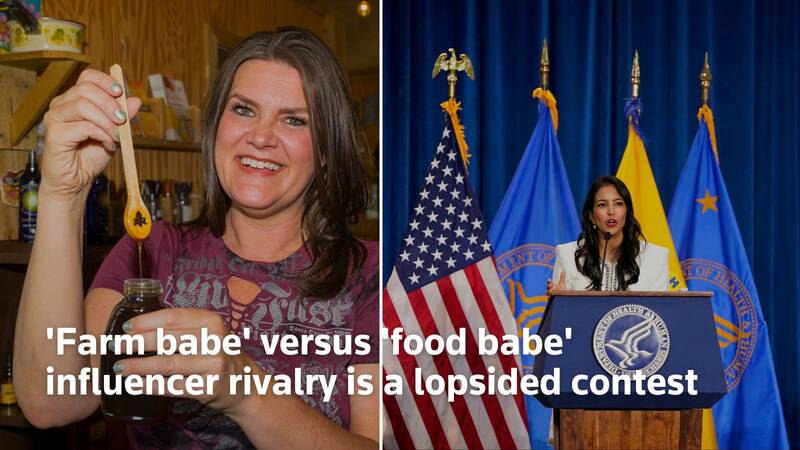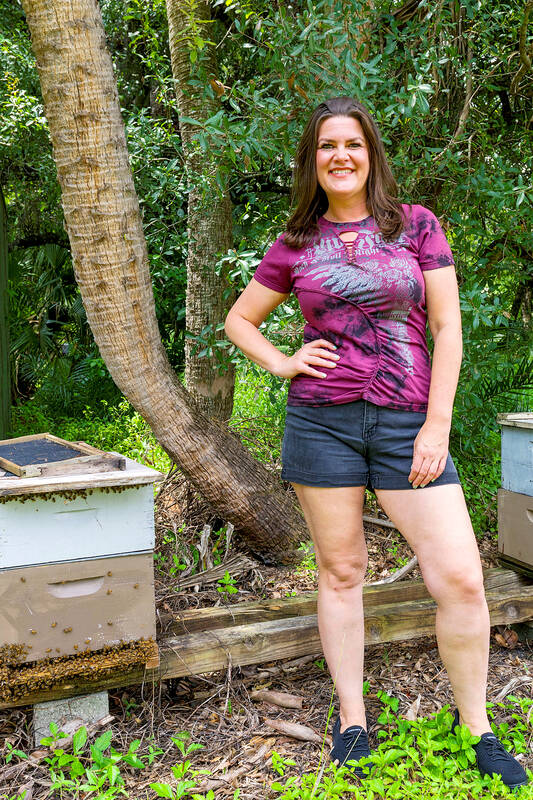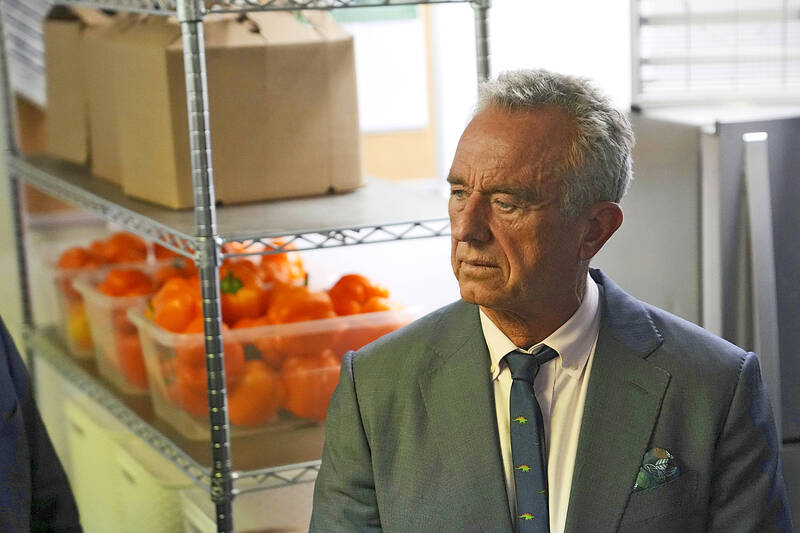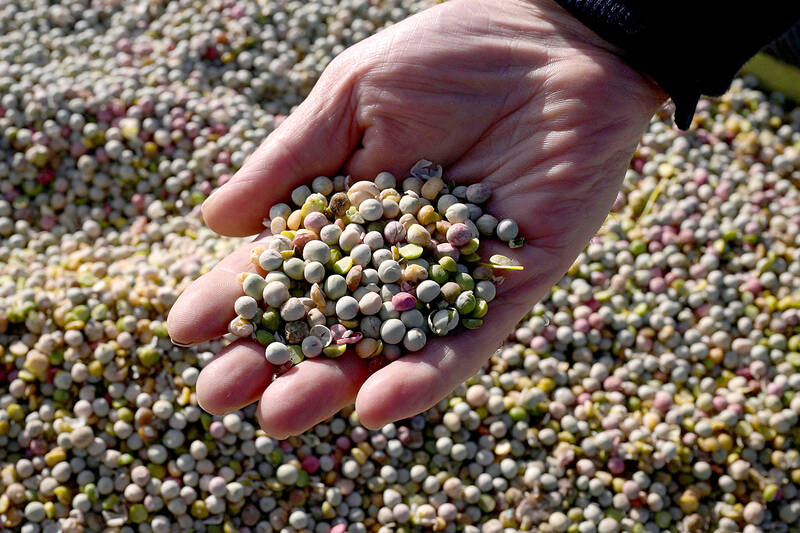Michelle Miller stands in a field of corn, stalks stretching above her perfectly styled hair, holding a tiny microphone and addressing an audience online.
She was farming genetically-modified corn in Iowa in 2017, she says, when a tornado hit. Now a social media influencer who goes by the name the “Farm Babe,” Miller says the wind knocked her corn flat on the ground. But in a feat of botanical fortitude, the plants bounced back.
“So when you ask farmers: why are they growing these GMO seeds?” she says in the video, “it’s because the genetics hold up.”

Photo: Reuters
Miller has starred in hundreds of videos, often set in fields and on farms, since she began her influencing career. She aims to debunk what she sees as misperceptions around farming perpetuated by another universe of influencers, many of whom are now closely aligned with Health and Human Services Secretary Robert F Kennedy, Jr, and his Make America Healthy Again, or MAHA, campaign.
But unlike Miller’s GMO corn, arguments in favor of the status quo in US food and agriculture are increasingly falling flat, especially on social media.
Among the most prominent of those MAHA influencers is Vani Hari, who blogs as “The Food Babe” — Miller says her own name is a self-conscious spin-off. Hari has gained millions of followers by railing against processed food, GMOs, pesticides and other mainstays of the US food system.

Photo: Reuters
Although Miller partners with powerful interests in the food and agriculture industry with huge marketing budgets, her message is not gaining as much traction as Hari’s. Her Instagram account, for example, had just over 43,000 followers as of this month, to Hari’s 2.3 million. The bloggers’ uneven rivalry speaks to the ascendance of a movement that has put conventional food and farming in its crosshairs, and Big Agriculture’s struggle to respond.
FOOD COMMENTATORS
Hari and Miller, both in their 40s, emerged as food commentators in the 2010s amid a boom in social media influencing, when a single post going viral could help rocket its author to fame and fortune.

Photo: AP
Their rise also coincided with growing national attention on the relationship between food, obesity and chronic illness, with then-First Lady Michelle Obama spearheading new regulations on school nutrition and promoting vegetable gardening and exercise through her “Let’s Move!” campaign.
Hari grew up in Charlotte, North Carolina, where she said she was largely raised on ultra-processed foods, to which she attributes later chronic health conditions, from eczema to endometriosis.
An appendectomy in 2002 launched her on a quest to understand the source of her health issues. She pored over books on nutrition at the library, from which she concluded that her diet was at the root of her diseases, and those of many other Americans.

Photo: AFP
“I wanted to investigate: what was it about these foods that made me feel so bad?” Hari said.
Hari began writing a blog in 2011 as The Food Babe, a name suggested by her husband, with the aim of educating her friends and family. The blog reached well beyond her immediate circle and led to book deals and the creation of Truvani, a line of supplements now sold at Target and Walmart.
More recently, she has become a sort of mascot of the MAHA movement, though she is a registered Democrat, according to public voter registration records. At a press conference in April, at which Kennedy announced the administration’s intention to phase out synthetic food dyes, Hari was an opening act, appearing in a bejeweled white suit before a room of press and MAHA supporters. When Kennedy took the stage, he called her an “extraordinary leader.” She said she does not have a formal role in the administration.

Photo: AFP
Miller wanted her own pulpit after she began noticing Hari’s content in 2014. A commercial farmer of soybeans, corn and livestock in Iowa at the time, Miller said she posted a comment on Hari’s Facebook page taking issue with her claims about the toxicity of GMO crops. After that, Miller said, she was blocked.
So, she launched a rival blog.
“I really took it upon myself to be a myth buster for the industry,” she said.
Hari did not respond to questions about blocking Miller or others who make critical comments.
Hari has published books blasting corruption in the food industry as well as her own cookbooks, and sells subscriptions to her blog. The supplements, however, are her main business, Hari said. She declined to disclose the company’s value.
Miller, who said she is not registered with either political party, travels about 300 days a year, doing paid speaking engagements, farm visits and branded partnerships with companies like Tyson Foods, Domino’s Pizza and the California Beef Council. She also writes a column for an agriculture industry trade publication.
She declined to say exactly how much she earns, but her published fee for speeches ranges from US$2,500 to US$15,000.
NEW DEMOGRAPHIC
Mariah Wellman, a professor of advertising and public relations at Michigan State University who focuses on social media and wellness, said both women likely earn in the high six figures for their work.
But they speak to different audiences. And the constraints of traditional public relations may hinder pro-agriculture messaging, while the MAHA crowd’s comfort with social media helps propel its narrative.
“When you think about large brands and large agricultural companies, they are headed by a demographic that’s not super comfortable with influencer culture,” said Wellman.
She said that such companies often find it hard to keep up with fast-moving social media trends as they like to vet their partnerships carefully.
Miller, for her part, is sometimes frustrated by the challenges of working with an industry that is less nimble on social media, noting that it skews older and male, and saying it is often “preaching to the choir.” But she sees it as part of her mission to help agriculture better communicate about itself. Hari has gained traction as public skepticism of U.S. public health institutions grew during the COVID-19 crisis. And her profile exploded when Kennedy, a longtime vaccine skeptic and environmental lawyer who was involved in suing companies like Bayer Monsanto over its pesticides, joined President Donald Trump’s administration.
Kennedy’s MAHA zeal has already inspired corporate action and state legislation on food.
In June, Kraft Heinz and General Mills announced they would phase out synthetic food dyes, which MAHA adherents believe cause problems ranging from hyperactivity in children to cancer, by 2027. Scientists say there is not yet a large enough body of evidence to show whether synthetic food dyes cause these problems.
West Virginia in March banned some synthetic food dyes from being sold in the state, and Arizona and Utah have recently banned a list of synthetic food dyes in school meals. Communications firm Edelman found in a large, global public opinion survey taken in 2024 that people, especially those aged 18-34, are increasingly disregarding the advice of credentialed medical providers in favor of recommendations from friends, family and social media.
As Lauri Baker, a professor of agricultural communication at the University of Florida, says: “In almost any study we’ve conducted, people are more likely to trust someone who looks like them, thinks like them, who they believe is like them.”

Following the shock complete failure of all the recall votes against Chinese Nationalist Party (KMT) lawmakers on July 26, pan-blue supporters and the Chinese Communist Party (CCP) were giddy with victory. A notable exception was KMT Chairman Eric Chu (朱立倫), who knew better. At a press conference on July 29, he bowed deeply in gratitude to the voters and said the recalls were “not about which party won or lost, but were a great victory for the Taiwanese voters.” The entire recall process was a disaster for both the KMT and the Democratic Progressive Party (DPP). The only bright spot for

Water management is one of the most powerful forces shaping modern Taiwan’s landscapes and politics. Many of Taiwan’s township and county boundaries are defined by watersheds. The current course of the mighty Jhuoshuei River (濁水溪) was largely established by Japanese embankment building during the 1918-1923 period. Taoyuan is dotted with ponds constructed by settlers from China during the Qing period. Countless local civic actions have been driven by opposition to water projects. Last week something like 2,600mm of rain fell on southern Taiwan in seven days, peaking at over 2,800mm in Duona (多納) in Kaohsiung’s Maolin District (茂林), according to

Aug. 11 to Aug. 17 Those who never heard of architect Hsiu Tse-lan (修澤蘭) must have seen her work — on the reverse of the NT$100 bill is the Yangmingshan Zhongshan Hall (陽明山中山樓). Then-president Chiang Kai-shek (蔣介石) reportedly hand-picked her for the job and gave her just 13 months to complete it in time for the centennial of Republic of China founder Sun Yat-sen’s birth on Nov. 12, 1966. Another landmark project is Garden City (花園新城) in New Taipei City’s Sindian District (新店) — Taiwan’s first mountainside planned community, which Hsiu initiated in 1968. She was involved in every stage, from selecting

The great number of islands that make up the Penghu archipelago make it a fascinating place to come back and explore again and again. On your next trip to Penghu, why not get off the beaten path and explore a lesser-traveled outlying island? Jibei Island (吉貝嶼) in Baisha Township (白沙鄉) is a popular destination for its long white sand beach and water activities. However, three other permanently inhabited islands in the township put a unique spin on the traditional Penghu charm, making them great destinations for the curious tourist: Yuanbeiyu (員貝嶼), Niaoyu (鳥嶼) and Dacangyu (大倉嶼). YUANBEIYU Citou Wharf (岐頭碼頭) connects the mainland